Development of Acoustic Insulating Carpets from Milkweed Fibers Using Air-Laid Spike Process
Abstract
1. Introduction
2. Materials and Methods
2.1. Material
2.2. Sample Preparation
2.3. Characterization of the Samples
2.3.1. Physical Properties
2.3.2. Porosity
2.3.3. Compression and Recovery Properties
2.3.4. Moisture Regain
2.3.5. Microstructure Analysis
2.3.6. Thermo-Acoustic Insulating Properties
2.3.7. Sound Absorption
2.3.8. Airflow Resistivity
3. Results and Discussion
3.1. Microstructural Analysis
3.2. Thermal Insulation
3.3. Analysis of Sound Absorption Coefficient
3.3.1. Effect of the Incorporation of a 30 mm Deep Cavity on Sound Absorption Coefficient
3.3.2. Effect of the Mass per Unit Area on the Sound Absorption Coefficient
3.4. Effect of Density and Porosity on Airflow Resistivity
3.5. Analysis of Compression Resistance and Short-Term Compression Recovery
3.6. Analysis of Moisture Regain
4. Conclusions
Author Contributions
Funding
Data Availability Statement
Acknowledgments
Conflicts of Interest
References
- Infographie: Mobilité: Les Modes de Transport Les Plus Utilisés au Quotidien. Available online: https://fr.statista.com/infographie/28271/modes-transport-les-plus-utilises-par-pays-mobilite-domicile-travail (accessed on 5 August 2024).
- Normand, X. Recycling of automotive textiles. In Textile Advances in the Automotive Industry; Shishoo, R., Ed.; Woodhead Publishing in Textiles: Cambridge, UK, 2008; pp. 86–109. [Google Scholar]
- Kellie, G. Developments in composite nonwovens and related materials. In Advances in Technical Nonwovens; Woodhead Publishing in Textiles: Cambridge, UK, 2016; p. 219. [Google Scholar]
- Saricam, C.; Nazan, O. Polyester Usage for Automotive Application. In Polyester—Production, Characterization and Innovative Applications; Camlibel, N.O., Ed.; IntechOpen: Rijeka, Croatia, 2018; pp. 69–71. [Google Scholar]
- Hagege, R. Filage textile. In Materiaux/Plastiques et Composites; Techniques de l’ingénieur, Ed.; Techniques de l’ingénieur: Paris, France, 1998; Réf AM3740 V1. [Google Scholar]
- Mcneil, S. The Thermal Properties of Wool Carpets; Technical Bulletin; AgResearch: Lincoln, New Zeland, 2016. [Google Scholar]
- Pollock, C.M. Nonwoven materials for automotive applications. In Proceedings of the 37th Annual Nonwoven Fabrics Conference; Clemson University Professional Advancement and Continuing Education: Clemson, SC, USA, 2008. [Google Scholar]
- Smith, C. Nonwovens in automotives-more than just a pretty face. Int. Nonwovens J. 2004, 3, 60–63. [Google Scholar] [CrossRef]
- Atakan, R.; Sezer, S.; Karakas, H. Development of nonwoven automotive carpets made of recycled PET fibers with improved abrasion resistance. J. Ind. Text. 2020, 49, 835–857. [Google Scholar] [CrossRef]
- Hassanzadeh, S.; Zarrebini, M.; Hasani, H. An Investigation into Acoustic Properties of Lightly Needled Estabragh Nonwovens Using the Taguchi Method. J. Eng. Fibers Fabr. 2014, 9, 155892501400900303. [Google Scholar] [CrossRef]
- Liu, X.; Yan, X.; Zhang, H. Sound absorption model of kapok-based fiber nonwoven fabric. Text. Res. J. 2015, 85, 969–979. [Google Scholar] [CrossRef]
- Mussig, J. What Are Natural Fibres. In Industrial Applications of Natural Fibres: Structure, Properties and Technical Applications; Müssig, J., Ed.; John Wiley & Sons Ltd.: Hoboken, NJ, USA, 2010; pp. 41–46. [Google Scholar]
- Ovlaque, P. Valorisation de la fibre d’asclépiade pour le renforcement de matrices organiques. Ph.D. Thesis, University of Sherbrooke, Sherbrooke, QC, Canada, June 2019. [Google Scholar]
- Yang, X.; Huang, L.Q.; Cheng, L.D. Study on the Structure and the Properties of Akund Fiber. Appl. Mech. Mater. 2012, 217–219, 617–621. [Google Scholar]
- Sanchez-Diaz, S.; Ouellet, C.; Elkoun, S.; Robert, M. Evaluating the Properties of Native and Modified Milkweed Floss for Applications as a Reinforcing Fiber. J. Nat. Fibers 2023, 20, 2174630. [Google Scholar] [CrossRef]
- Campeau, S.; Panneton, R.; Elkoun, S. Experimental Validation of an Acoustical Micro-Macro Model for Random Hollow Fibre Structure. Acta Acust. United Acust. 2019, 105, 240–247. [Google Scholar] [CrossRef]
- Müller, U.; Jost, T.; Kurzböck, C.; Stadlmann, A.; Wagner, W.; Kirschbichler, S.; Baumann, G.; Pramreiter, M.; Feist, F. Crash simulation of wood and composite wood for future automotive engineering. Wood Mater. Sci. Eng. 2020, 15, 312–324. [Google Scholar] [CrossRef]
- Karthik, T.; Murugan, R. A Potential Sustainable Natural Fibre Crop. In Sustainable Fibres for Fashion Industry; Muthu, S.S., Gardetti, M., Eds.; Springer: Singapore, 2016; pp. 111–146. [Google Scholar]
- Azwa, Z.N.; Yousif, B.F.; Manalo, A.C.; Karunasena, W. A review on the degradability of polymeric composites based on natural fibres. Mater. Des. 2013, 47, 424–442. [Google Scholar] [CrossRef]
- Richard, C.; Cousin, P.; Foruzanmehr, M.; Elkoun, S.; Robert, M. Characterization of components of milkweed floss fiber. Sep. Sci. Technol. 2019, 54, 3091–3099. [Google Scholar] [CrossRef]
- Baley, C. Fibres naturelles de renfort pour matériaux composites. In Archives; Techniques de l’ingénieur, Ed.; Techniques de l’ingénieur: Paris, France, 2013; Réf AM5130 V2. [Google Scholar]
- Oksman, K. High Quality Flax Fibre Composites Manufactured by the Resin Transfer Moulding Process. J. Reinf. Plast. Compos. 2001, 20, 621–627. [Google Scholar] [CrossRef]
- Oksman, K.; Wallström, L.; Berglund, L.; Toledo Filho, R. Morphology and mechanical properties of unidirectional sisal– epoxy composites. J. Appl. Polym. Sci. 2002, 84, 2358–2365. [Google Scholar] [CrossRef]
- Hornsby, P.; Hinrichsen, E.; Tarverdi, K. Preparation and properties of polypropylene composites reinforced with wheat and flax straw fibres: Part I Fibre characterization. J. Mater. Sci. 1997, 32, 443–449. [Google Scholar] [CrossRef]
- Olhan, S.; Khatkar, V.; Behera, B.K. Review: Textile-based natural fibre-reinforced polymeric composites in automotive lightweighting. J. Mater. Sci. 2021, 56, 18867–18910. [Google Scholar] [CrossRef]
- Penu, C.; Helou, M. Acide polylactique (PLA). In Matériaux | Matériaux Fonctionnels—Matériaux Biosourcés; Techniques de l’ingénieur, Ed.; Techniques de l’ingénieur: Paris, France, 2017; Réf AM3317 V1. [Google Scholar]
- Santhanam, S.; Temesgen, S.; Atalie, D.; Ashagre, G. Recycling of cotton and polyester fibers to produce nonwoven fabric for functional sound absorption material. J. Nat. Fibers 2019, 16, 300–306. [Google Scholar] [CrossRef]
- Parikh, D.V.; Chen, Y.; Sun, L. Reducing Automotive Interior Noise with Natural Fiber Nonwoven Floor Covering Systems. Text. Res. J. 2006, 76, 813–820. [Google Scholar] [CrossRef]
- Oldham, D.J.; Egan, C.A.; Cookson, R.D. Sustainable acoustic absorbers from the biomass. Appl. Acoust. 2011, 72, 350–363. [Google Scholar] [CrossRef]
- Ganesan, P.; Karthik, T. Development of acoustic nonwoven materials from kapok and milkweed fibres. J. Text. Inst. 2016, 107, 477–482. [Google Scholar] [CrossRef]
- Veerakumar, A.; Selvakumar, N. A preliminary investigation on kapok/polypropylene nonwoven composite for sound absorption. Indian J. Fibre Text. Res. 2012, 37, 385–388. [Google Scholar]
- Hasani, H.; Zarrebini, M.; Zare, M.; Hassanzadeh, S. Evaluating the Acoustic Properties of Estabragh (Milkweed)/Hollow- Polyester Nonwovens vfor Automotive Applications. J. Text. Sci. Eng. 2014, 4. [Google Scholar]
- Dharmendrasinh Vikramsinh, B. Study Acoustic Properties of Estrabragh-Kapok Natural Fiber Fabric for Technical Uses. Ph.D. Thesis, Maharaja Sayajirao University of Baroda, Vadodara, India, 2020. [Google Scholar]
- Gharehaghaji, A.A.; Davoodi, S.H. Mechanical damage to estabragh fibers in the production of thermobonded layers. J. Appl. Polym. Sci. 2008, 109, 3062–3069. [Google Scholar] [CrossRef]
- ISO 9073-1:2023; Nonwovens—Test Methods—Part 1: Determination of Mass Per Unit Area. ISO: Geneva, Switzerland, 2023.
- ISO 9073-2:21995; Nonwovens—Test Methods—Part 2: Determination of Thickness. ISO: Geneva, Switzerland, 1995.
- ASTM D6571-22; Standard Test Method for Determination of Compression Resistance and Recovery Properties of Highloft Nonwoven Fabric Using Static Force Loading. ASTM: West Conshohocken, PA, USA, 2022.
- ASTM D2654-22; Standard Test Methods for Moisture in Textiles. ASTM: West Conshohocken, PA, USA, 2022.
- ASTM D1776/D1776M-20; Standard Practice for Conditioning and Testing Textiles. ASTM: West Conshohocken, PA, USA, 2020.
- ASTM C518-21; Standard Test Method for Steady-State Thermal Transmission Properties by Means of the Heat Flow Meter Apparatus. ASTM: West Conshohocken, PA, USA, 2021.
- ASTM E1050-19; Standard Test Method for Impedance and Absorption of Acoustical Materials Using a Tube, Two Microphones and a Digital Frequency Analysis System. ASTM: West Conshohocken, PA, USA, 2019.
- ASTM C522-03-16; Standard Test Method for Airflow Resistance of Acoustical Materials. ASTM: West Conshohocken, PA, USA, 2016.
- Küçük, M.; Korkmaz, Y. Acoustic and Thermal Properties of Polypropylene Carpets: Effect of Pile Length and Loop Density. Fibers Polym. 2019, 20, 1519–1525. [Google Scholar] [CrossRef]
- Diswat, J.; Hes, L.; Bal, K. Thermal resistance of cut pile hand tufted carpet and its prediction. Text. Res. J. 2016, 86, 1759–1767. [Google Scholar] [CrossRef]
- Crews, P.C.; Sievert, S.A.; Woeppel, L.T.; Mccullough, E.A. Evaluation of Milkweed Floss as an Insulative Fill Material. Text. Res. J. 1991, 61, 203–210. [Google Scholar] [CrossRef]
- Liu, X.; Yan, X.; Li, L.; Zhang, H. Sound-Absorption Properties of Kapok Fiber Nonwoven Fabrics at Low Frequency. J. Nat. Fibers. 2015, 12, 311–322. [Google Scholar] [CrossRef]
- Coates, M.; Kierzkowski, M. Acoustic textiles—Lighter, thinner and more absorbent. Tech. Text.-Int. 2002, 17, 15–18. [Google Scholar]
- Pfretzschner, J.; Simón, F.; Colina, C. Acoustic Absorbent Panels with Low Perforation Coefficient. 2004. Available online: https://digital.csic.es/bitstream/10261/8589/1/ID48.PDF (accessed on 8 August 2024).
- Zakriya, M.; Ramakrishnan, G.; Gobi, N.; Palaniswamy, N.; Srinivasan, J. Jute-reinforced non-woven composites as a thermal insulator and sound absorber. J. Reinf. Plast. Compos. 2017, 36, 206–213. [Google Scholar] [CrossRef]
- Mahmoud, A.; El-Shenawy, G.; Ramadan, E. Using Nonwoven Hollow Fibers to Improve Cars Interior Acoustic Properties. Res. J. Text. Appar. 2012, 16, 49–56. [Google Scholar] [CrossRef]
- Paul, P.; Ahirwar, M.; Behera, B.K. Influence of airflow resistance on acoustic behaviour of needle-punched nonwoven structures. J. Text. Inst. 2024, 1–13. [Google Scholar] [CrossRef]
- Rey, R.D.; Alba, J.; Arenas, J.P.; Ramis, J. Technical Notes: Evaluation of Two Alternative Procedures for Measuring Airflow Resistance of Sound Absorbing Materials. Arch. Acoust. 2023, 38, 547–554. [Google Scholar] [CrossRef]
- Erdoğan, Ü.H. Effect of pile fiber cross section shape on compression properties of polypropylene carpets. J. Text. Inst. 2012, 103, 1369–1375. [Google Scholar] [CrossRef]
- Castagne, B.; Aknine, A.; Brouard, B.; Tarnow, V. Effects of compression on the sound absorption of fibrous materials. Appl. Acoust. 2000, 61, 173–182. [Google Scholar] [CrossRef]
- Dunne, R.; Desai, D.; Sadiku, R.; Jayaramudu, J. A review of natural fibres, their sustainability and automotive applications. J. Reinf. Plast. Compos. 2016, 35, 1041–1050. [Google Scholar] [CrossRef]
- Abednigo Jabu, M.; Alugongo, A.; Nkomo, N. Application of Natural Fibre Composites in Interior Panels in the Automotive Industry: A Review. Int. J. Eng. Trends Technol. 2024, 72, 91–98. [Google Scholar] [CrossRef]

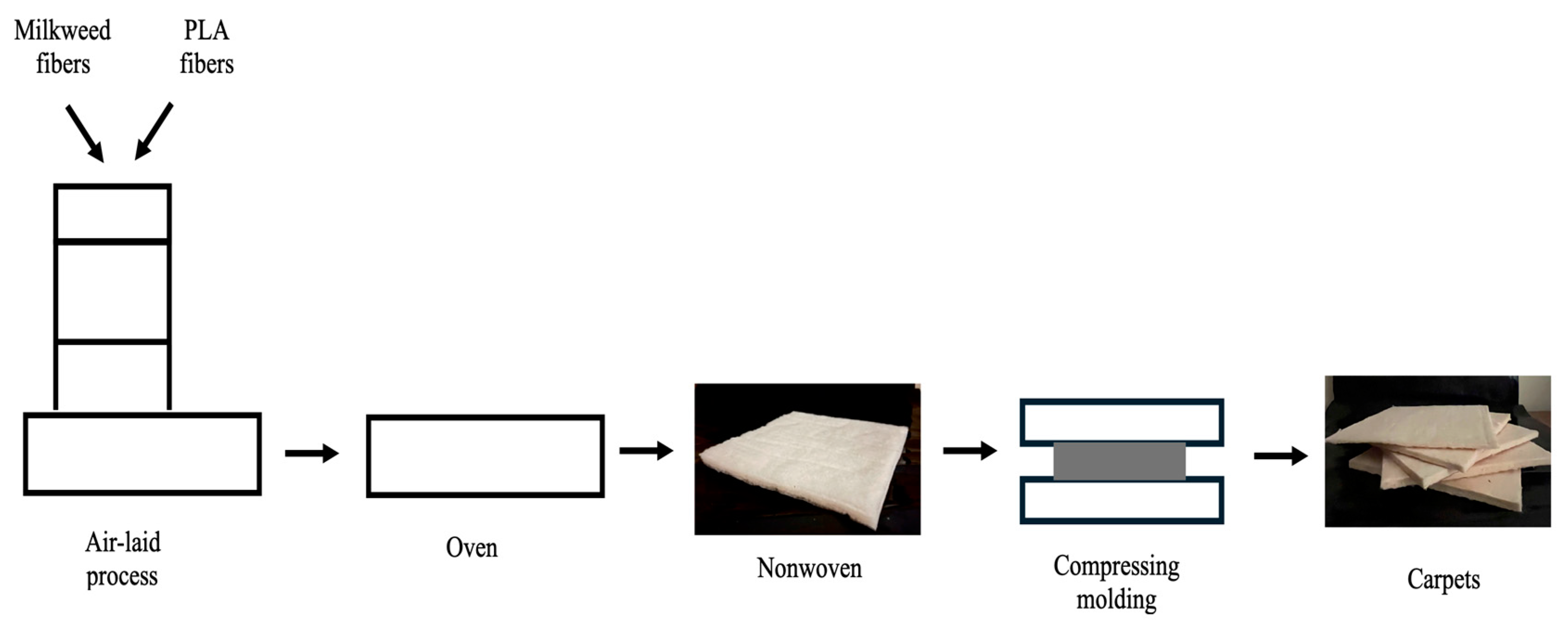
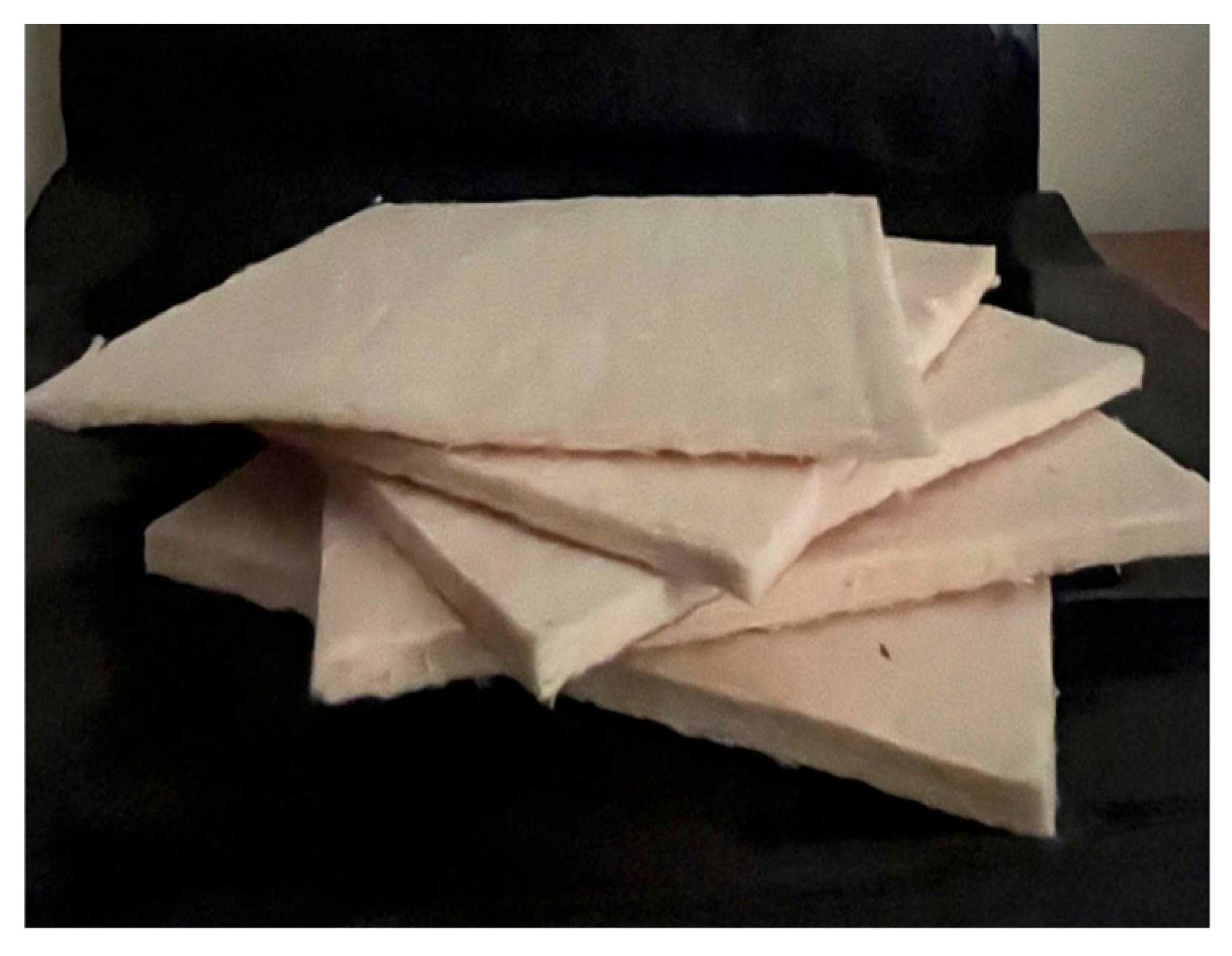


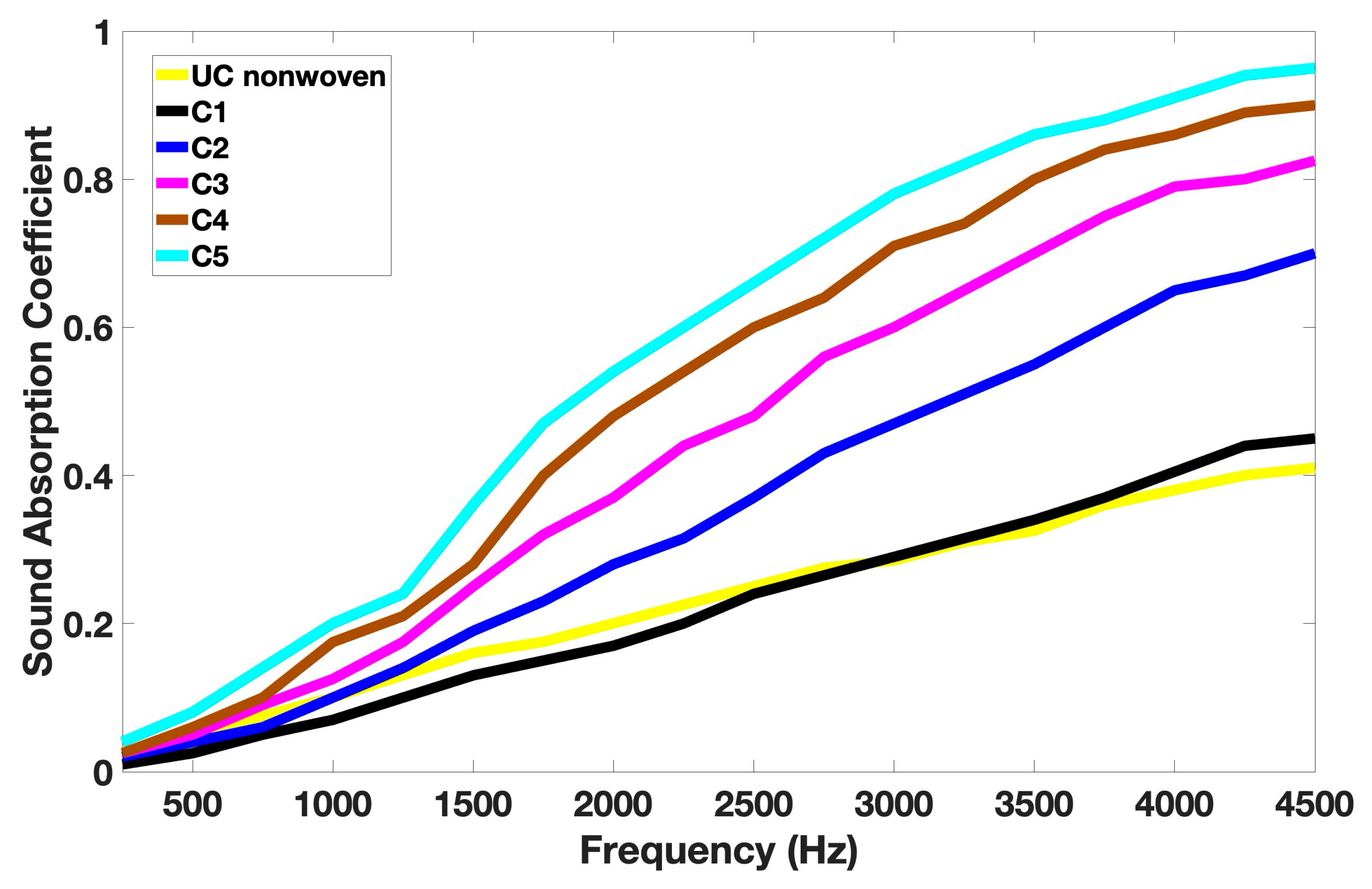

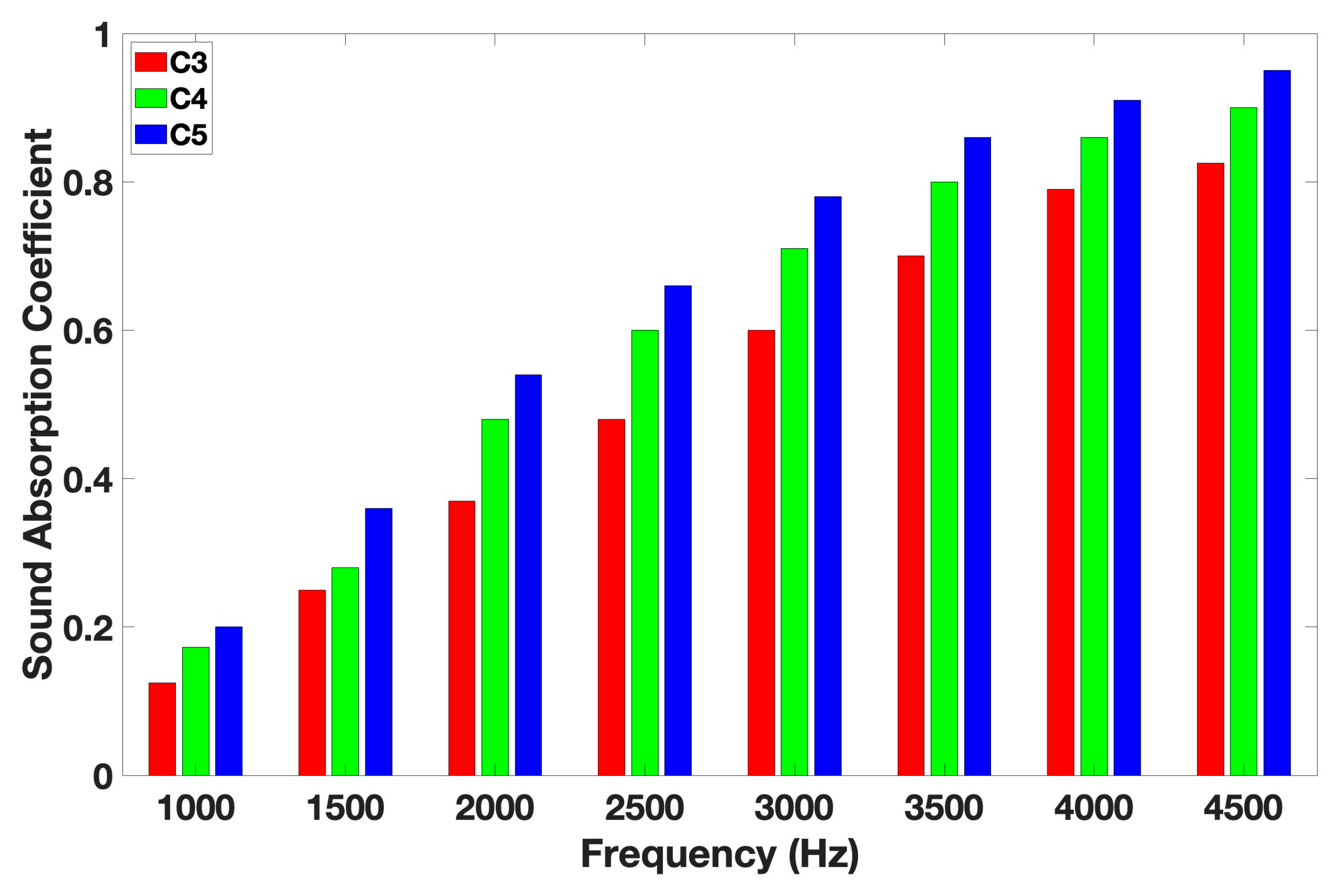
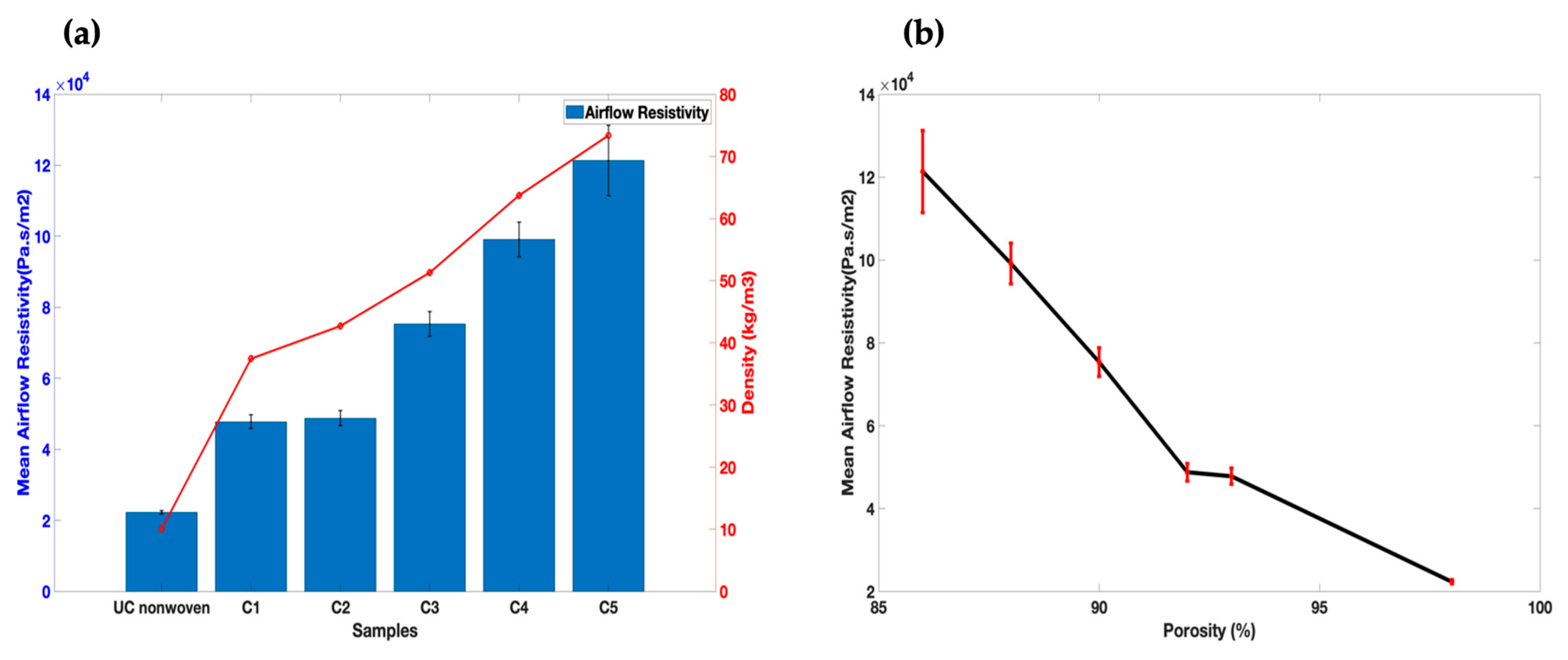
| Sample | Number of Layers | Mean Ma (g/m2) | Standard Deviation Ma (g/m2) | Mean TH (mm) | Standard Deviation TH (mm) | Porosity (%) |
|---|---|---|---|---|---|---|
| Nonwoven | 0 uncompressed (UC) | 152.74 | 1.02 | 11.97 | 0.69 | 98 |
| Carpet-1 (C1) | 2 | 207.03 | 0.54 | 5.53 | 0.62 | 93 |
| Carpet-2 (C2) | 3 | 335.35 | 0.55 | 7.85 | 0.34 | 92 |
| Carpet-3 (C3) | 4 | 443.51 | 1.26 | 8.65 | 0.46 | 90 |
| Carpet-4 (C4) | 5 | 551.01 | 0.95 | 8.65 | 0.42 | 88 |
| Carpet-5 (C5) | 6 | 634.69 | 0.79 | 8.65 | 0.51 | 86 |
| Samples | Average λ (mW/m·K) | Standard Deviation λ (mW/m·K) | Thermal Resistance R (m2·K)/W | Thermal Insulation (clo) |
|---|---|---|---|---|
| UC nonwoven | 37.45 | 0.04 | 0.31 | 2.02 |
| C1 | 32.04 | 0.07 | 0.17 | 1.11 |
| C2 | 32.19 | 0.03 | 0.24 | 1.57 |
| C3 | 32.13 | 0.13 | 0.27 | 1.71 |
| C4 | 32.22 | 0.09 | 0.27 | 1.71 |
| C5 | 32.54 | 0.03 | 0.27 | 1.71 |
| Samples | Density (kg/m3) | Porosity (%) |
|---|---|---|
| UC nonwoven | 12.76 | 98 |
| C1 | 37.44 | 93 |
| C2 | 42.70 | 92 |
| C3 | 51.29 | 90 |
| C4 | 63.72 | 88 |
| C5 | 73.37 | 86 |
| Samples | Compression Resistance (%) | Compression (%) | Short-Term Compression Recovery (%) |
|---|---|---|---|
| UC nonwoven | 51.0 ± 6.6 | 49.0 ± 6.6 | 84 ± 3.6 |
| C1 | 96.7 ± 2.0 | 3.3 ±2.0 | 99.7 ± 3.1 |
| C2 | 94.5 ± 3.4 | 5.5 ± 3.4 | 98.5 ± 2.9 |
| C3 | 91.9 ± 2.9 | 8.1 ± 2.9 | 98.9 ± 2.5 |
| C4 | 94.0 ± 4.1 | 6.0 ± 4.1 | 98.0 ± 3.6 |
| C5 | 95.6 ± 3.1 | 4.4 ± 3.1 | 97.8 ± 3.6 |
| Samples | Moisture Regain (%) |
|---|---|
| UC nonwoven | 5.02 |
| C1 | 4.50 |
| C2 | 4.16 |
| C3 | 4.46 |
| C4 | 3.98 |
| C5 | 5.10 |
Disclaimer/Publisher’s Note: The statements, opinions and data contained in all publications are solely those of the individual author(s) and contributor(s) and not of MDPI and/or the editor(s). MDPI and/or the editor(s) disclaim responsibility for any injury to people or property resulting from any ideas, methods, instructions or products referred to in the content. |
© 2025 by the authors. Licensee MDPI, Basel, Switzerland. This article is an open access article distributed under the terms and conditions of the Creative Commons Attribution (CC BY) license (https://creativecommons.org/licenses/by/4.0/).
Share and Cite
Lupescu, D.; Robert, M.; Elkoun, S. Development of Acoustic Insulating Carpets from Milkweed Fibers Using Air-Laid Spike Process. Fibers 2025, 13, 4. https://doi.org/10.3390/fib13010004
Lupescu D, Robert M, Elkoun S. Development of Acoustic Insulating Carpets from Milkweed Fibers Using Air-Laid Spike Process. Fibers. 2025; 13(1):4. https://doi.org/10.3390/fib13010004
Chicago/Turabian StyleLupescu, Deborah, Mathieu Robert, and Said Elkoun. 2025. "Development of Acoustic Insulating Carpets from Milkweed Fibers Using Air-Laid Spike Process" Fibers 13, no. 1: 4. https://doi.org/10.3390/fib13010004
APA StyleLupescu, D., Robert, M., & Elkoun, S. (2025). Development of Acoustic Insulating Carpets from Milkweed Fibers Using Air-Laid Spike Process. Fibers, 13(1), 4. https://doi.org/10.3390/fib13010004






